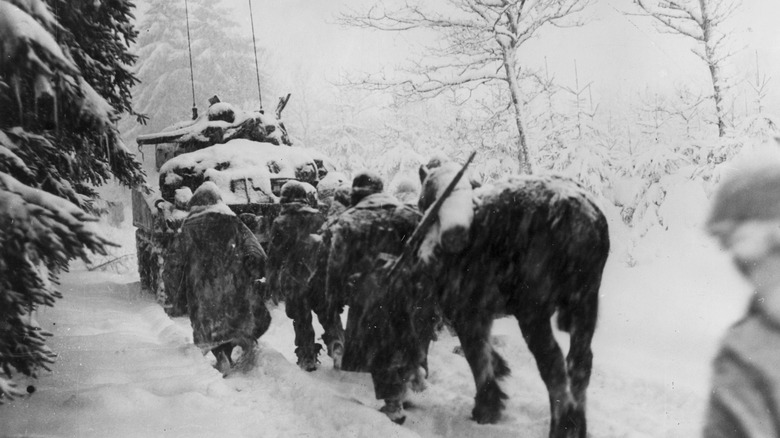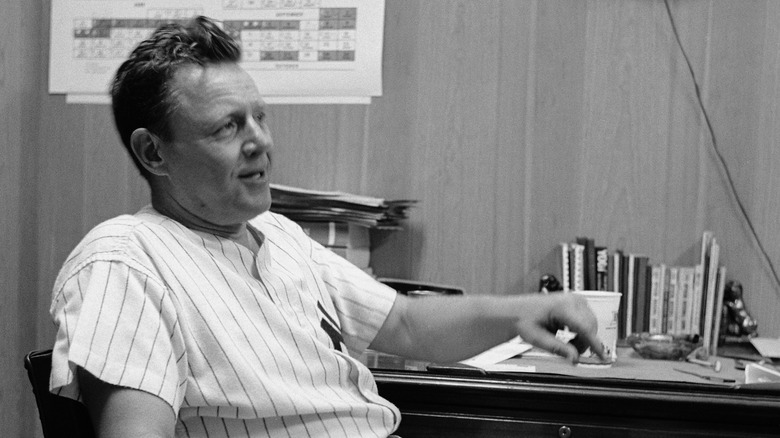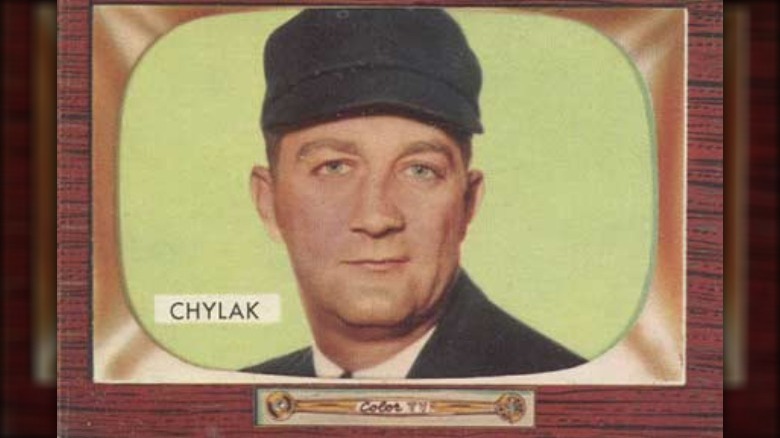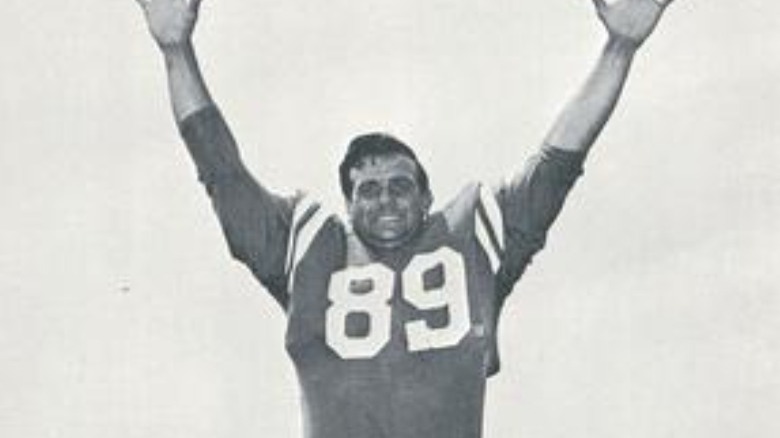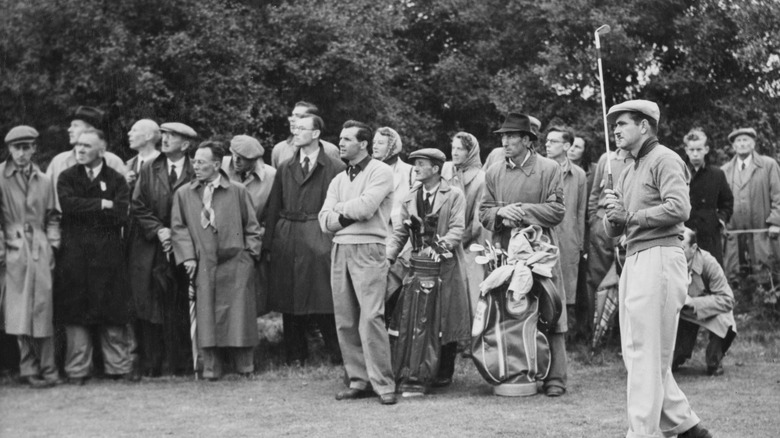Which Battle Of The Bulge Soldiers Were Also Famous Sports Figures?
The Battle of the Bulge was a major moment during World War II, so much so that Winston Churchill called the battle "the greatest American battle of the war." The battle marked one of Hitler's final offensive pushes before the end of the war and took place in Belgium's densely forested Ardennes region, per History. The battle lasted six weeks, from December 1944 through January 1945, meaning that soldiers had to endure frigid temperatures during the fight.
The battle's name comes from a bulge that developed in the Allied forces' line when the Germans launched an attack that pushed them back. The United States Army alone suffered 100,000 casualties in the battle, making it the costliest single battle the U.S. Army has ever seen. By the time the fighting was over, countless trees in the Ardennes Forest had been mowed down due to the combat.
According to the National Veterans Memorial Museum, around 1 million troops in total were involved in the Battle of the Bulge. Among them were some figures from the sports world.
Baseball: Ralph Houk
Ralph Houk spent part of his playing career in the minor leagues, but also spent some time with the New York Yankees, typically as a backup catcher for Yogi Berra. By the 1960s he was a Major League manager. He spent more than two decades in the big leagues managing the New York Yankees, Detroit Tigers, and Boston Red Sox. According to Society for American Baseball Research (SABR), Houk still has the distinction of being the only manager to win back-to-back World Series in his first two seasons.
Houk and his brother Harold both joined the Army in 1942, just a few months after the United States entered the war. Houk managed the baseball team at Fort Leavenworth in Kansas and was also in charge of a barracks full of recruits, something he later said helped him in his managerial career. By 1944, Houk arrived on European soil. He landed on Omaha Beach several days after D-Day, and was greeted with a bullet that struck his helmet, but fortunately missed him otherwise. Houk was also in the Ardennes Forest during the Battle of the Bulge and later wrote about his experiences.
"Suddenly all hell broke loose," Houk said. "They opened the attack with a furious barrage; followed by wave after wave of Hitler's battle-tested troopers ... Panzer divisions ... were turned loose on us." According to Insider, Houk suffered a calf injury in battle. He earned several awards for his service, including a Purple Heart and Silver Star.
Also baseball: Nestor Chylak
Nestor Chylak is enshrined at the Baseball Hall of Fame in Cooperstown, New York. However, it's not for his career as a player or manage;, it's for his career as an umpire. Chylak was a student at Rutgers University until he left university life behind to enlist in the United States military during World War II. Chylak wound up in Europe and became the sergeant of an Army Ranger battalion, per SABR.
In early 1945, Chylak was in Belgium fighting in the Battle of the Bulge. On January 3, a nearby shell explosion sent metal and tree shrapnel flying, some of which hit Chylak. He lost his eyesight for around 10 days and spent eight weeks in the hospital, but managed to recover his vision and heal up. He received a Silver Star and a Purple Heart for his service.
After returning home from the war, Chylak started working as an umpire, first calling amateur games before moving his way through the ranks. In 1954 — just under 10 years after his injuries in Belgium — Chylak made his Major League debut. He continued working as an American League umpire until 1978 and is regarded as one of the era's best and most consistent umpires.
Football: Gino Marchetti
Gino Marchetti is a Football Hall of Famer and regarded as one of the best defensive ends of the 1950s. However, before making a name for himself as a member of the formidable 1950s Baltimore Colts, Marchetti served in the Army. Marchetti joined the military after finishing high school and took part in the Battle of the Bulge as a machine gunner.
According to The New York Times, immediately after the war, Marchetti returned to his home in Antioch, California and worked for his father, who owned a tavern. Marchetti's path to the NFL, and eventually the Hall of Fame, was highly unusual. The then-bartender was at the horse track when a junior recruiter noticed his size — 6' 4” and 244 pounds, per Football Reference — and figured he might make for a good football player. Sure enough, Marchetti became a star player at Modesto Junior College before transferring to the University of San Francisco.
The Dallas Texans drafted Marchetti 14th overall in the 1952 NFL Draft, and he spent one season in Dallas before landing in Baltimore, where he spent 13 seasons. He was named to 11 Pro Bowls and helped the Colts win a pair of back-to-back NFL championships in 1958 and 1959. Marchetti was voted into the Hall of Fame in 1972 and died in 2019 at the age of 93.
Golf: Lloyd Mangrum
Lloyd Mangrum was a professional golfer, and before he went overseas to Europe as part of the U.S. war effort he already had five PGA Tour victories on his resume. According to Golf, Mangrum would occasionally write letters from the frontlines to Fred Corcoran, who was in charge of the Tour at the time. In one, Mangrum lamented the fact that he wasn't exactly getting a lot of time to work on his golf game. "I am getting a lot of practice with rifle, machine gun, etc., where I am, but not golf," he wrote.
While other notable professional golfers of the era served in the military, most remained stateside, leaving Mangrum one of the few to see combat, and did he ever. Not only was Mangrum involved in the Battle of the Bulge, months earlier he was part of the Allied Forces D-Day invasion of Normandy. Mangrum earned two Purple Hearts, two Silver Stars, and two Bronze Stars for his service.
Upon returning to the United States after the war, Mangrum jumped right back into professional golf. He won the 1946 U.S. Open after playoffs and extended the tournament to 108 holes. He went on to win another 30 PGA tour victories. According to Insider, Mangrum was known for his calm demeanor — possibly cultivated during the war — which earned him the nickname "Mr. Icicle."
